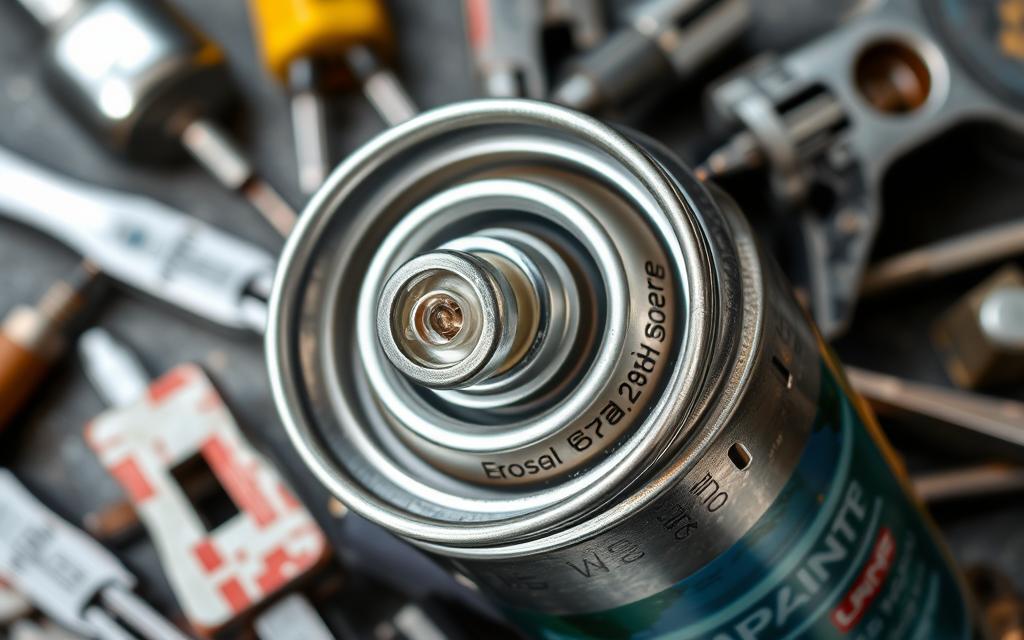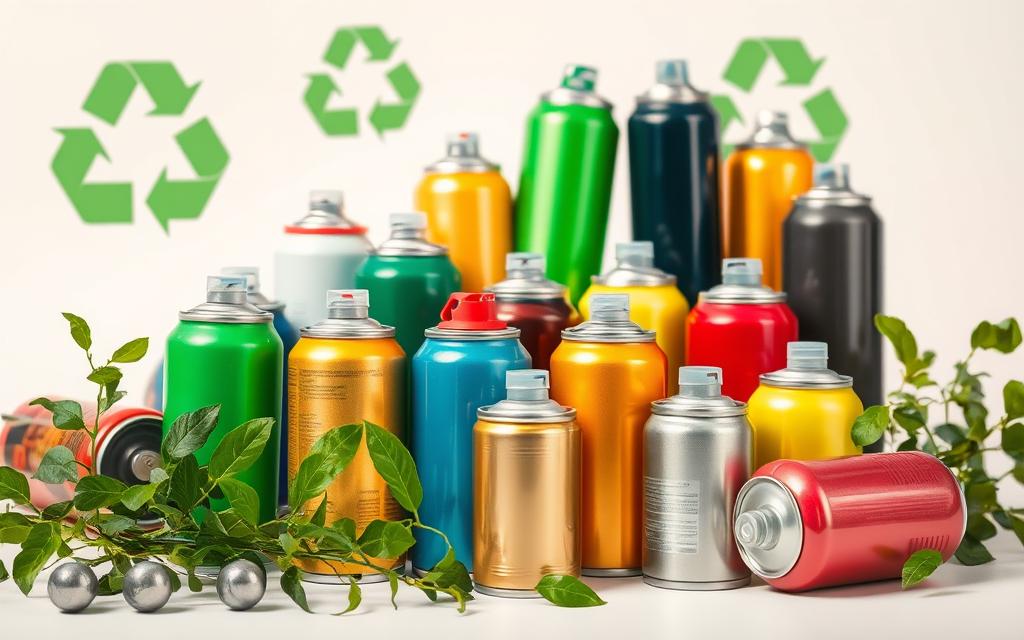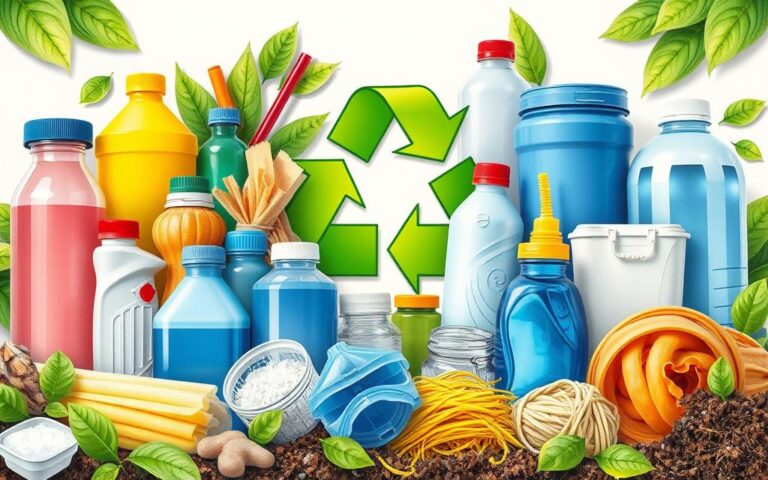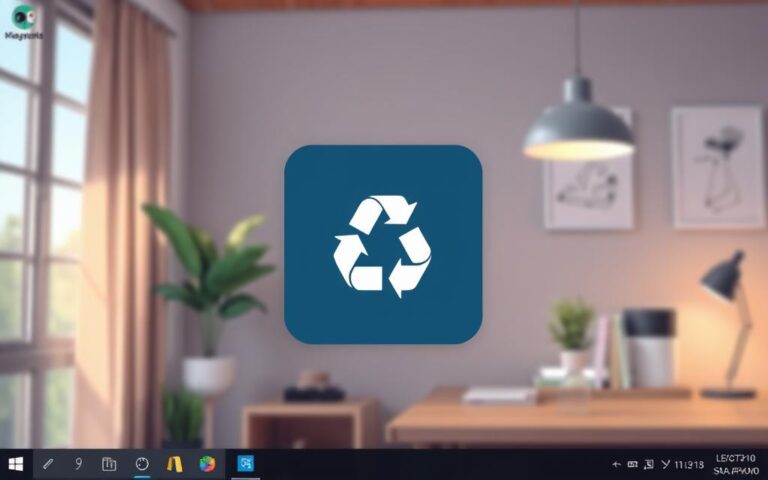Can You Recycle Aerosol Spray Cans? Proper Disposal Guide
Aerosol spray cans are everywhere in our daily lives. But, many people wonder how to dispose of them properly. These cans are usually made from aluminium or steel. Both are easily recyclable materials. Yet, the cans also contain pressurised air and sometimes dangerous materials. This makes it tricky to recycle them safely.
Throwing them away incorrectly can harm the environment. It’s vital to learn the right way to handle them. In the US, around 3.5 billion aerosol cans are made each year. Sadly, only 30 percent of these are recycled. This shows the importance of better recycling habits and raising awareness.
Introduction to Aerosol Spray Cans
Aerosol spray cans are vital in many areas, offering ease of use for different products. They are common in homes and industries. These cans contain a variety of items like personal care products, cleaning agents, and paints. Knowing about the different types of aerosol cans can help people choose wisely and dispose of them properly.
The bodies of aerosol cans are usually made from steel or aluminium. Both materials can be recycled. However, only 30% of these cans are actually recycled. This low number points to a big problem in waste management and the environment with regards to aerosol cans.
Aerosol cans work by using pressurized propellants to spray the contents evenly. We use them daily in items like cooking sprays, insecticides, and solvents. It’s important to know how to dispose of them correctly. Not doing so can harm the environment and increase waste. By using and throwing away aerosol cans responsibly, we can reduce their negative impact on nature.
Understanding the Construction of Aerosol Cans
Aerosol cans have a pressurised structure that helps spray out contents like paints, cleaners, and personal care items. These cans are mainly made from steel and aluminium. About 75% are steel, with aluminium making up 25%. The materials chosen are key for the cans’ usefulness and how well they can be recycled.
Steel cans usually include 35% recycled material, marking them as quite eco-friendly. However, even “empty” aerosol cans can retain some product or gas inside. They’re only considered empty if less than 3% of the content or 1 inch of liquid is left in them.

It’s important to correctly identify if a can is empty for safe recycling. If decided as empty, they can often go straight into recycling bins, according to your local rules. Yet, cans still holding contents might explode if thrown away carelessly. Hence, they should be handled with extra care. Artists and local businesses sometimes use these cans, offering a creative way to reuse them instead of wasting.
In certain areas, aerosol cans are seen as universal waste. This means they have easier rules for handling if done correctly. But, recycling standards differ everywhere, so knowing your area’s rules is essential. By understanding what aerosol cans are made of and how they’re recycled, we can throw away less and protect our planet.
Why is Proper Disposal of Aerosol Cans Important?
Not disposing of aerosol cans properly leads to big risks. These risks can harm both our environment and people’s safety. Each year, the United States makes about 3.5 billion aerosol cans. Sadly, many end up in landfills with regular trash. This is worrying because these cans often have dangerous stuff in them, like cleaning fluids and paints.
The EPA says aerosol cans are hazardous waste. That’s because of the harmful chemicals and propellants they might have. Getting rid of them the wrong way can pollute the environment. It might also get people and businesses into trouble with the law. This is if they don’t follow the rules on hazardous waste regulations. The EPA made some changes in 2020. They added aerosol cans to the Universal Waste Regulations. This makes it easier to manage and dispose of them safely.
Right now, only about 30% of aerosol cans get recycled. The rest could harm people who work in recycling or landfills. To make sure cans don’t pose a risk, they have to be nearly empty. This means they can’t have more than 3% of what they originally had inside them. All places that make waste have to follow this rule. It doesn’t matter how big or small they are. This shows why it’s key for everyone to follow these rules.
| Aspect | Details |
|---|---|
| Annual Production | 3.5 billion aerosol cans in the US |
| Landfill Contribution | Aerosol cans mixed with general waste |
| Recycling Rate | Only 30% are recycled |
| Universal Waste Inclusion | Effective from December 2019 |
| Legal Classification | Considered hazardous waste by the EPA |
Using the right ways to dispose of them, like draining systems, lowers risks. It also helps with recycling. Raising awareness about aerosol can disposal risks and following the rules helps protect our environment and keeps us safe.
Can You Recycle Aerosol Spray Cans?
It’s important to know how to recycle aerosol cans rightfully, for the sake of our planet. Local recycling programs help in correctly handling these items. This prevents them from becoming dangerous waste. Whether your cans can be recycled depends on where you live, as each place has its own rules about aerosol disposal.
Acceptance in Local Recycling Programs
In many areas, local recycling programs do accept aerosol cans. Yet, this is not the same everywhere. Some places have the right setup for safely recycling cans, but others see them as hazardous. Always check with your local rules on recycling acceptance before you recycle your cans. If the can is empty according to the Environmental Protection Agency, it’s good to recycle.
What to Do if the Can is Not Accepted
If you find aerosol cans can’t be recycled in your area, don’t worry. You have other safe options for disposal. Many areas have specific sites for getting rid of hazardous waste safely. They might even have special events for collecting such items. Using these services helps prevent any harm or accidents, like fires, at recycling centers.
Properly disposing of aerosol cans is crucial for protecting our environment and communities. If you’re looking for more tips on how to dispose of these cans safely, check out this resource.
Aerosol Can Recycling Preparation
Getting aerosol cans ready for recycling is key for careful waste handling. It’s important to prepare aerosol cans for recycling by ensuring they’re fully used up before throwing them away. This means using the product until nothing is left inside. Aerosol cans must have less than 3% of their content by weight to be safe. This stops them from being a hazard.
We should also take off any plastic caps. These can often go into recycling separately, helping our environment. Following recycling guidelines keeps the process safe and efficient.
Puncturing aerosol cans is very risky and must be avoided. Doing so can cause fires at recycling plants. This threat highlights the need for correct disposal methods.
Finding places to recycle empty aerosol cans is easier with recycling locators. These services show where to bring cans for safe handling. This not only aids the planet but also protects people involved in recycling.
Steps for Safe Disposal of Aerosol Spray Cans
Handling aerosol cans needs careful safety and environmental care. Following the correct steps helps dispose of empty aerosol cans responsibly. This encourages recycling and lowers hazards from not disposing of properly. Here’s what you should do:
How to Ensure Cans are Empty
Make sure aerosol cans are truly empty before disposal, to stick to guidelines. A can is seen as “RCRA-empty” if it holds 0.3% or less ignitable materials. To check if cans are empty, try these methods:
- Shake the can to listen for liquid. If it sloshes, use it more.
- Keep spraying until nothing comes out and there’s no hissing sound. This shows it’s empty.
- Don’t try to puncture or remove the nozzle. It’s dangerous.
Utilising Professional Hazardous Waste Services
If you have many aerosol cans, using a professional hazardous waste service is wise. They have professional disposal methods for safely handling aerosol cans. Using these services helps you follow laws and avoid disposal risks. Look at these options:
| Model | Applications | Capacity | Price Range |
|---|---|---|---|
| Aerosolv 5000 | General use, household | Handles different sizes of cans | Affordable |
| Aerosolv 360 | For lots of cans | Can work with 4,000 cans in a big drum | Moderate price |
| Aerosolv 7000 XL | Meets California’s rules | Made for more cans | Pricey |
By taking these steps and choosing the right services, you can dispose of aerosol cans safely. This helps the environment and follows rules. It’s a big help in reducing aerosol waste impact.
Conclusion
Properly getting rid of aerosol cans is key to reducing harm to our environment. These cans are mostly made of tinplated steel and aluminium, which can be recycled. Doing so cuts down on waste. When we recycle recycling aerosol cans responsibly, we help protect the future. This stops them from adding to landfill problems.
Knowing how to dispose of them correctly is important. It keeps us in line with local laws and helps our community care for the Earth. Companies like Unilever Australia work hard to recycle more. They show us how businesses can help create a world that reuses what we can.
We should think about how we can be more eco-friendly. Join in with local recycling efforts. The Aerosol Can Disposal Guide helps us make choices that are good for the planet. Let’s live in a way that shows we respect the Earth every day.
FAQ
Can I recycle aerosol spray cans?
Yes, you can recycle aerosol spray cans. But, it depends on your local area’s recycling rules. Always check the guidelines in your place.
What should I do if my local recycling does not accept aerosol cans?
If your area does not recycle aerosol cans, try contacting nearby hazardous waste sites. You can also join in special waste disposal events.
How can I safely prepare aerosol cans for recycling?
To recycle aerosol cans safely, make sure they’re totally empty. Take off any plastic lids to recycle them by themselves. Remember, don’t punch a hole in the cans. It’s dangerous.
How can I tell if an aerosol can is empty?
An aerosol can is empty when it has less than 3% left inside. Shake it to hear if there’s liquid. Also, make sure there’s no pressure left inside.
Why is it important to dispose of aerosol cans properly?
Correct disposal of aerosol cans stops pollution and fires. If not done right, it could result in legal problems. Plus, protect people and nature from danger.
What are the environmental impacts of improperly disposed aerosol cans?
Improper disposal can lead to fires and leaking of dangerous chemicals. This pollution harms our health and the environment, affecting local areas.
Are there professional services for disposing of aerosol cans?
Yes, professional services exist for safe aerosol can disposal. They follow laws and lower risks to health and the environment.















